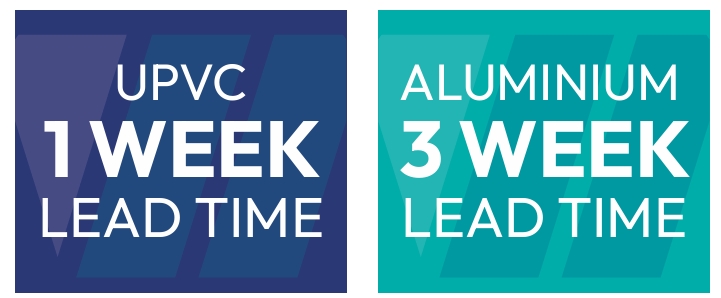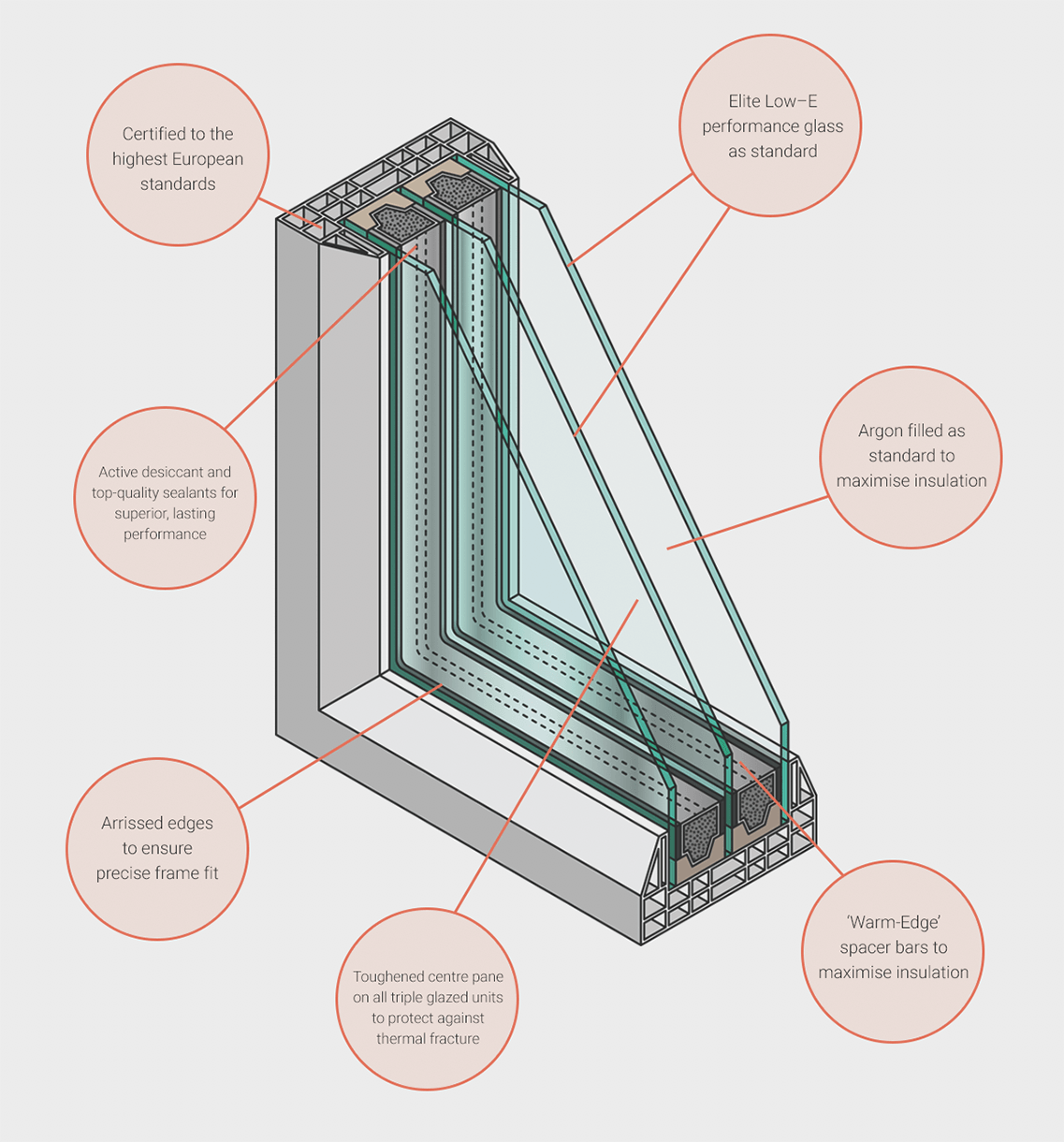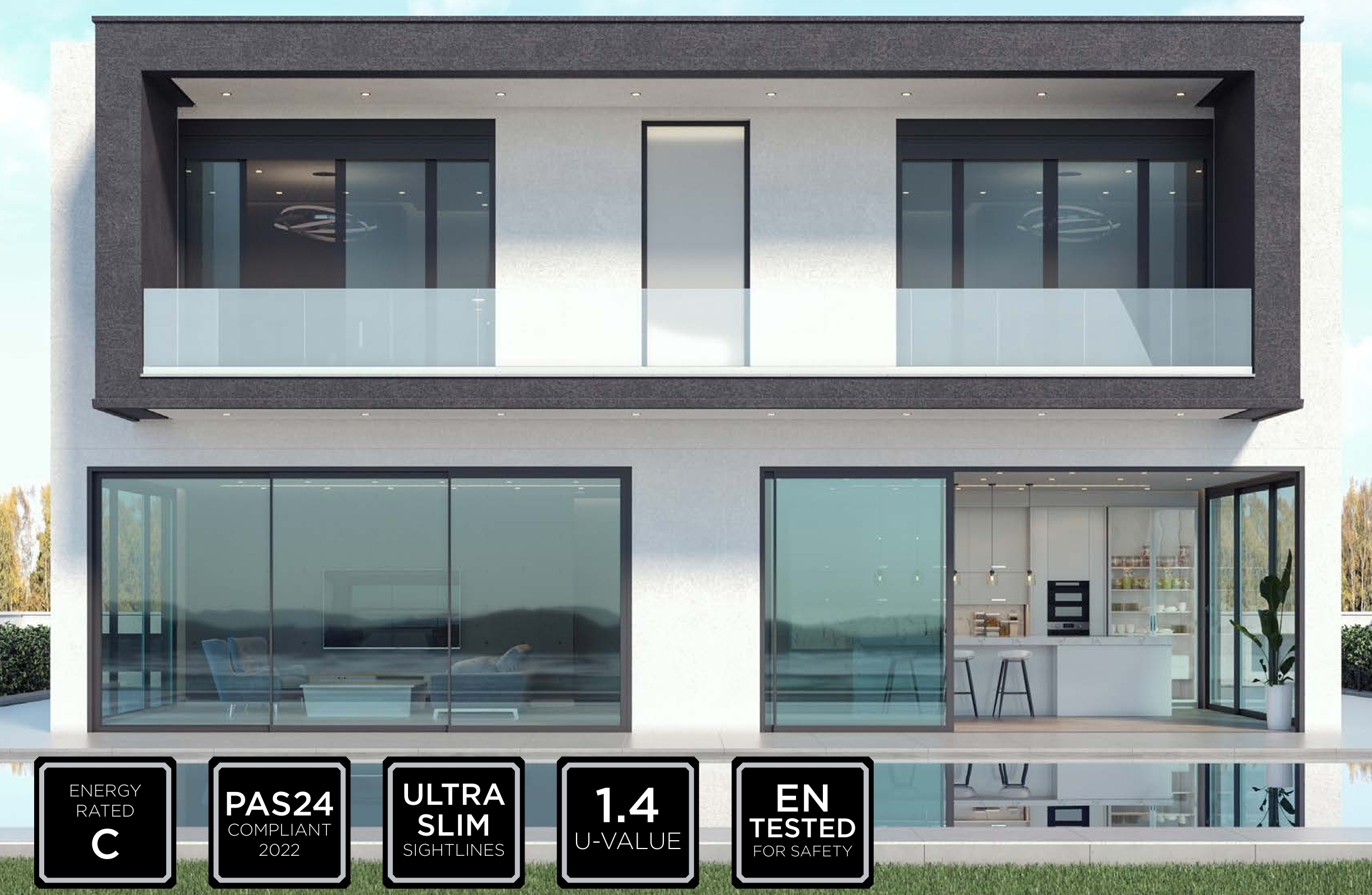Ultimate uPVC Windows Buyer’s Guide 2026: How to Choose the Best for Your Glasgow Home
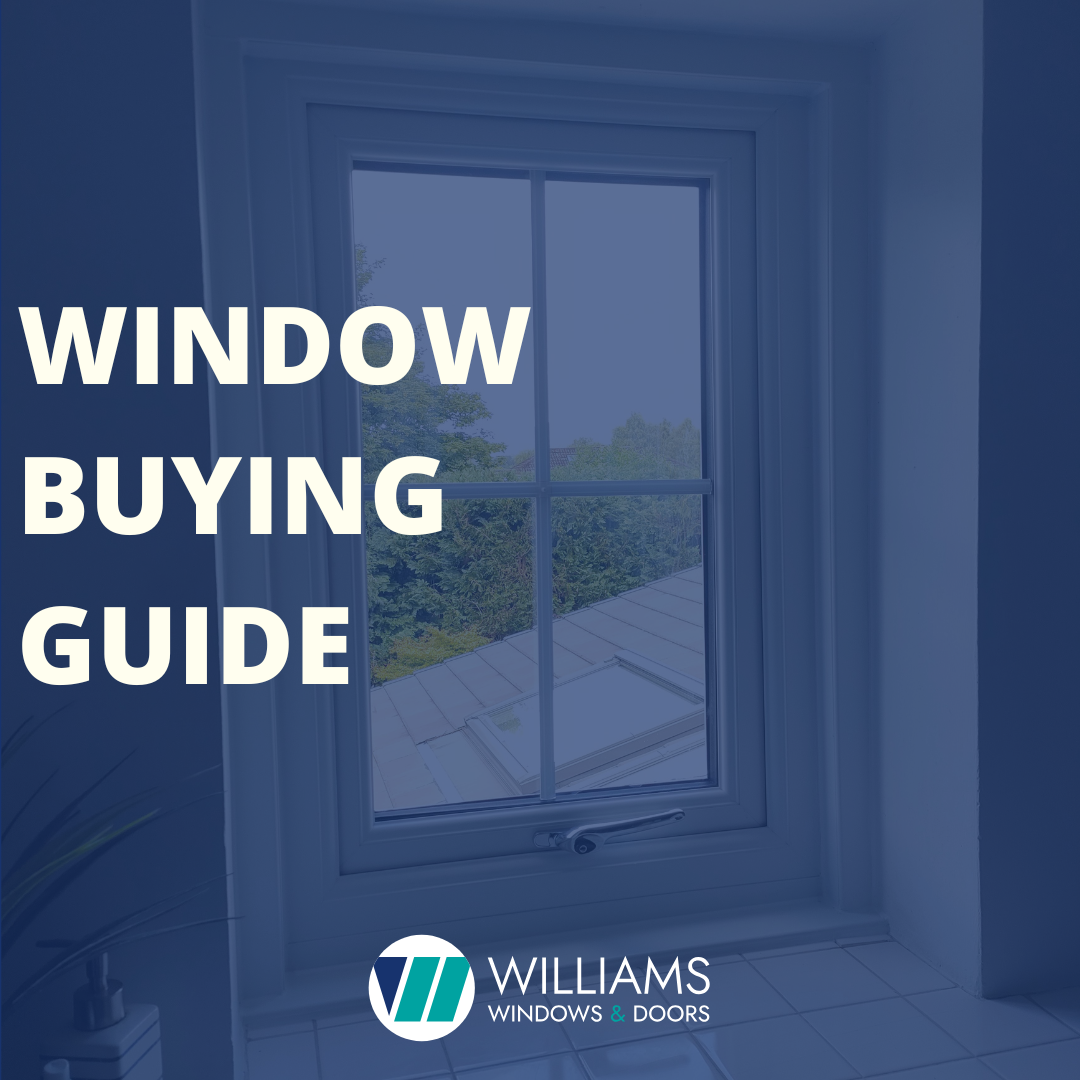
- 11 August 2025
- Doors
Ultimate uPVC Windows Buyer’s Guide 2026: How to Choose the Best for Your Glasgow Home
Contents:
- Regulations and Planning Permission for New Windows
- Energy Efficiency and U-values for Double Glazing
- Window Design: Choosing the Right Style for Your Home
• Casement Windows – Versatile and Energy Efficient
• Sliding Sash Windows – Traditional Style with Modern Benefits
• Tilt & Turn Windows – Easy Cleaning and Ventilation
• Bay & Bow Windows – Adding Space and Light - Choosing Window Colours and Finishes
- Privacy Glass and Obscure Glazing Options
- Home Security with Modern Windows
• Key Components & Multi-Point Locking Mechanisms
• Security Standards & PAS 24 Accreditations - Care and Maintenance for Long-Lasting Windows
- Quality and Durability: What to Look For
- Noise Reduction with Double and Triple Glazing
• How Double Glazing Reduces Traffic and Street Noise
• Factors That Influence Noise Reduction Performance - uPVC vs Aluminium vs Timber Windows – Comparison Table
- Window Jargon Buster – Common Terms Explained
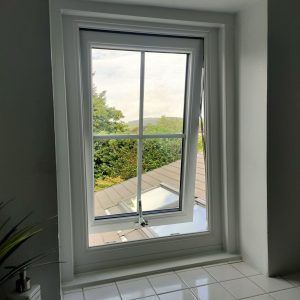
1) Regulations and Planning Permission for New Windows
You do not need planning permission for replacement windows. But, if you’re in a conservation area or your property is listed, you may face restrictions about the type or style of window you can have. Check with your local authority for more advice.
Good news for those living in conservations areas is that new regulations in Scotland now permit a ‘prior notification’ process, rather than requiring full planning permission, for replacing old single-glazed windows with modern double-glazed units in conservation areas. This is provided the new window’s design (opening, pane configuration, frame dimensions/colour, astragal bars) is not “substantially the same” as the original and the alteration is on a principal or road-facing side elevation. Crucially, the material of the window frames is no longer a restrictive condition, meaning uPVC double-glazing can now be considered in these areas, subject to the planning authority’s 28-day review and potential prior approval request regarding design and external appearance.
However, we do not obtain permissions on your behalf. Please make sure everything is in place before placing your order.
Our uPVC Sliding Sash windows are an amazing product for upgrading an old home, whilst maintaining the same aesthetic and style of the original windows.
2) Energy Efficiency and U-values for Double Glazing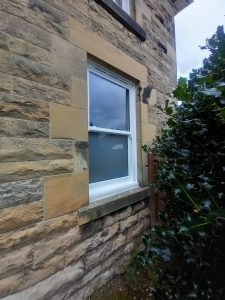
Just like fridges, freezers and washing machines, windows and doors use an ‘A’ to ‘E’ energy rating system. A++ are the best-performing models; E the worst.
The Windows (and Doors) Energy Rating (WER & DER) schemes are independently operated by the British Fenestration Ratings Council (BFRC), a subsidiary of the Glass and Glazing Federation (GGF).
A-rated windows are increasingly popular because they offer a substantial improvement in performance. 95% of BFRC-certified A++ rated windows are made from uPVC, while C-rated windows are now the minimum standard required to comply with current Building Regulations.
According to the Energy Saving Trust, upgrading single glazed windows to A-rated double glazing can save £140 on energy bills in Scotland. With modern technology in the window systems and glass, there are three key advantages:
- A more comfortable home: Energy efficient glazing reduces heat loss through windows and means fewer draughts and cold spots.
- Peace and quiet: Not only do they keep the heat in, energy efficient windows in Glasgow insulate your home against external noise.
- Reduced condensation: Energy efficient double glazing reduces condensation build up on the inside of windows.
3) Window Design: Choosing the Right Style for Your Home
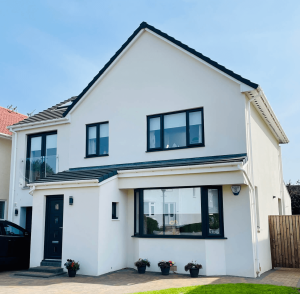
White House Black UPVC Windows
Choosing the right window design is about balancing aesthetic appeal with functionality, ventilation, and light. While casement windows remain a popular classic, modern manufacturing techniques and evolving tastes have led to a diverse range of window types, each with its own unique benefits.
- Casement Windows Casement windows are the most common style in the UK. They can be hinged at the side and open outwards like a door, or hinged at the top and push out from the bottom. Their simple design, clean lines, and ability to provide maximum ventilation make them a versatile and popular choice for both traditional and modern homes. A single casement can be a full-height sash, or it can be combined with a fixed pane or a top-opening “light” for a more classic look. Because casement windows open out the way, when the wind howls against your property, it is increasing the tightness of the seal, keeping the warmth in your house. Contrast this with a tilt and turn, which opens in the way. When the wind blows against a tilt and turn, it pushing against the seal. A tilt and turn window of the same age and quality of an equivalent casement window will be more draughty. That’s part of the reason that a casement is a more popular window choice.
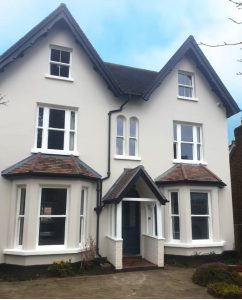
EcoSlide Sliding Sash Windows installed in Glasgow Home
- Sash & Case Windows Traditionally found in older properties, sliding sash windows are a classic and elegant option. They feature two sashes that slide vertically past each other. Our uPVC Sliding Sash windows offer the timeless, authentic aesthetic of timber but with the superior thermal efficiency, low maintenance, and security of modern uPVC. They are a perfect solution for upgrading a period home without compromising on style.
These windows are crafted from eco-conscious materials and offer advanced thermal insulation with U-values of just 1.2 W/(m²K). You can replace your draughty old single-pane timber windows with a modern, warm version, that never needs painted and doesn’t rot. They also open in the winter!
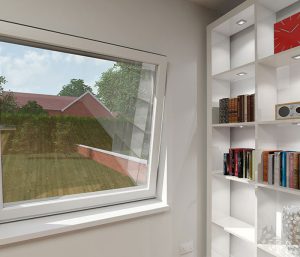
White Tilt & Turn Window
- Tilt & Turn Windows Tilt & Turn windows are a highly functional and secure modern option. They are a great space-saver, as they open inwards. A single handle controls two modes of operation: a slight turn of the handle allows the top of the window to tilt inwards for secure, draught-free ventilation, while a full turn allows the entire window to swing inwards for easy cleaning from the inside and maximum airflow. These are popular in flats, where upper level windows can be cleaned safely from inside the property. They aren’t quite as secure and draught-proof as casement windows, and are slightly more expensive. The other consideration is that blinds and curtains sit in the way of the inward-opening path of the window.
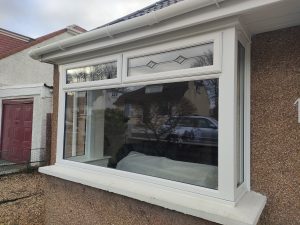
Bay Window with hoppers and decorative glass
- Bay & Bow Windows: Bay and bow windows are striking architectural features that extend outwards from the main wall of your home, creating a sense of increased space and flooding your room with natural light. While a bay window features a distinct angular shape with three or more sides, a bow window presents a gentler, more curved, semi-circular design. What makes these styles so versatile is that the outward-facing structure can be configured with almost any type of window. Whether you prefer the classic appeal of casement windows, the traditional charm of sliding sash, or the modern convenience of tilt & turn, each can be integrated into the bay or bow structure to create a unique and functional feature for your home’s exterior.
4) Choosing Window Colours and Finishes
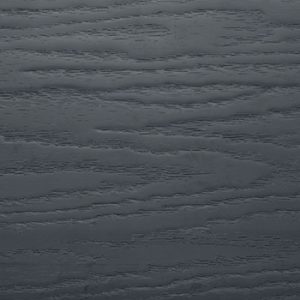
Anthracite Grey Woodgrain Texture
White remains the most popular choice, but a huge range of colours are now available. If you want to blend in with the environment, you can. And if you want to make a big, bold statement, you can do that too. The choice is yours.
Anthracite Grey (RAL 7016) is one of our best-selling colours for windows and doors, especially on modern properties. Our range also includes several more greys and our ‘heritage’ colours, such as Chartwell Green, which are perfect for stone-built houses. As a rule of thumb, a colour on the external side of windows costs an extra 30% over and above white. And if you want to have it coloured on the inside as well, it will cost extra again.
All coloured windows come with a woodgrain effect. For example, this anthracite grey window profile is manufactured to look like timber.
5) Privacy Glass and Obscure Glazing Options
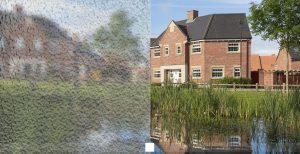
Stippolyte Obscure Glass
Privacy glazing is recommended in entrance areas (unless not looked over), bathrooms and upstairs landings. Frosted patterned ‘backing’ glass also features in our composite and uPVC entrance doors, obscuring the internal view from outside.
Privacy glass comes in a range of styles. The Pilkington Glass Visualiser is an excellent tool for seeing the different options available. Contora, Stippolyte and Satin are the three most popular choices for bathroom windows.
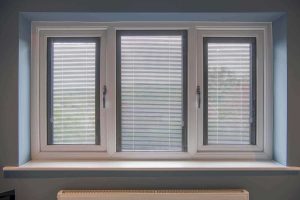
Integral Blinds in Double Glazed Units
There are other quick ways to create privacy, too. Consider integral blinds, which are a neat and stylish alternative to curtains, external blinds and other window dressings for your home or business. Choose from Venetian or pleated blinds which fit perfectly inside the double-glazed unit, and means they won’t get damaged and will never need cleaning.
6) Home Security with Modern Windows
Modern uPVC windows come equipped with a range of advanced security features that go far beyond what was available in older models. These features work together to create a robust barrier against forced entry, and many are designed to meet stringent industry-wide security standards.
Here are the key security features found on modern uPVC windows:
Key Components & Mechanisms
- Multi-Point Locking Systems: This is one of the most critical security features. Instead of a single central lock, modern windows have a system that engages at multiple points around the frame when the handle is locked. This bolts the window into the frame at several places, making it extremely difficult to pry open.
- Internal Glazing Beads: The glass in a double-glazed unit is held in place by strips called beads. On older windows, these beads were often on the exterior, allowing intruders to easily remove them and take out the glass. Modern uPVC windows are “internally beaded,” meaning the glass is secured from the inside, making it impossible to remove from the outside.
- Reinforced Frames: The uPVC frames themselves are reinforced with strong uPVC. This multi-chambered construction and internal reinforcement make the frames very difficult to force or cut through.
- Key-Locking Handles: Modern windows are fitted with key-operated handles as a standard feature. When locked, these handles prevent the window from being opened even if the glass is broken, adding an extra layer of security and providing a safety feature for homes with children.
- Toughened or Laminated Glass: The glass itself contributes to security. Double and triple glazing is inherently more resistant to being broken than single-pane glass. Windows can also be fitted with toughened or laminated glass, which is significantly harder to break and, in the case of lamination, holds shattered pieces in place, making entry almost impossible. Any glass below 800mm from the floor level must be toughened, by law.
Security Standards & Accreditations
To ensure a window is genuinely secure, look for products that have been tested and certified by official industry bodies.
- PAS 24: This is a British standard for enhanced security performance. PAS 24-certified windows have been independently tested to withstand various forms of attack from an opportunist burglar using common tools. The standard is a simple pass or fail, ensuring that products meet a minimum legal requirement for security. Look for PAS 24 windows to ensure your house is safe from intruders and insurable.
- Secured by Design (SBD): This is the official UK police security initiative. Products that carry the SBD logo and “Police Preferred Specification” have been tested to a higher standard and have met stringent criteria for deterring crime. SBD accreditation often requires products to have met the PAS 24 standard as a baseline. Make sure any window or door that you buy is Secured by Design.
7) Care and Maintenance for Long-Lasting Windows
uPVC windows require very little maintenance. They won’t rust or rot, but some effort should still be made to keep them in pristine condition.
If you live on the coast in the West of Scotland, the salt in the air will attack the metal in the hinges and mechanisms. Once a year, clean them well with WD40 to prevent rust.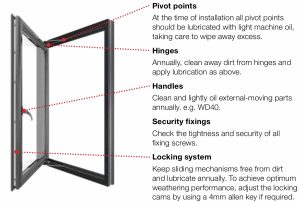
Our products are manufactured with a built in drainage system. To ensure this system works efficiently, the drainage slots must remain unblocked. To ensure the window is draining correctly, remove any dirt or debris, clear drain holes and check drainage operation by flushing through with water.
Manufactured in Clydebank and installed across Glasgow’s suburbs, our uPVC windows come with a 10-year guarantee
8) Quality and Durability: What to Look For
To ensure the longevity of your new windows and doors, look for three accreditations to give you ongoing peace of mind.
1) BBA Certified Systems: A BBA certificate is recognised throughout the construction industry. All Williams Windows & Doors are BBA-certified.
2) UKCA Marking: This proves that a product complies with UK and EU safety, health and environmental requirements.
3) British Standards: Williams Windows & Doors are manufactured to BS6375 and BS476.
Guarantees and warranties vary from supplier to supplier, and this is very important. Some window companies go to some lengths to appear to manufacture their product, but in fact buy as trade customers from a fabricator (such as us) and then install in your house. The manufacturer’s warranty is not passed on to you as the customer. Whilst they have surveyed and had them made-to-measure, they were not the manufacturer, and it is unlikely that their guarantee is worth the paper it is written on.
Advice: Always ask to visit the factory to see the windows/doors being made. This will give you peace of mind.
At Williams Windows & Doors we manufacture our products and guarantee our windows for 10 years, including the glass. That means that if there any issues, we’re back out to fix them for you. This gives customers peace of mind that their investment will last. Having been in business for almost 30 years – this really means something.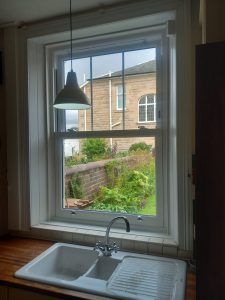
9) Noise Reduction with Double and Triple Glazing
Glasgow has a very busy airport, and many of our customers live near the flightpath. Your home may also face on to a busy road, or be near a school. Whatever the source of noise, new windows with double glazing are an excellent sound insulator, reducing external noise by 25 to 35 decibels (dB). This reduction can make a busy road sound like a low murmur and bring loud urban noise down to a much more comfortable background level inside your home.
How Double Glazing Reduces Noise
Double glazing is far more effective than single glazing because it creates a sophisticated barrier for sound waves.
- Two Panes of Glass: The two layers of glass act as a physical barrier. When a sound wave hits the first pane, some of its energy is reflected, and some is absorbed. The sound that passes through is significantly weakened.
- Sealed Gas Cavity: The space between the two panes is filled with an inert gas like argon. This gas is denser than air and helps to further dampen sound vibrations, making it more difficult for noise to travel from the outer pane to the inner one.
- Sealed Frame: High-quality uPVC frames and professional installation ensure a tight seal around the window. This prevents noise from leaking through small gaps or cracks, which is a major source of noise pollution in older windows.
Factors That Influence Noise Reduction
The amount of noise reduction you experience can vary depending on several factors beyond the basic double-glazed unit.
- Glass Thickness: Using glass panes of different thicknesses (e.g., one 4mm pane and one 6mm pane) is more effective at blocking noise than using two panes of the same thickness. This is because the different thicknesses vibrate at different frequencies, preventing sound from resonating and passing through the unit.
- Air Gap: The width of the gap between the glass panes is crucial. A larger gap, typically between 12mm and 20mm, generally provides better sound insulation. Our standard Double Glazing thickness is 22mm, with two panes of glass of 4mm, and a gap of 18mm (which is argon gas-filled).
- Acoustic Glass: For homes in extremely noisy areas (e.g., near an airport or train line), a specialist acoustic glass is the best option. This is a form of laminated glass that includes a sound-dampening polyvinyl butyral (PVB) interlayer, which can reduce noise by up to 40-45 dB.
10) uPVC vs Aluminium vs Timber Windows – Comparison Table
Feature / Factor | uPVC Windows | Aluminium Windows | Timber Windows |
Durability / Lifespan | 20–35 years with minimal care | 30–45 years with powder coating | 30–60 years with regular maintenance |
Maintenance | Very low – occasional cleaning | Very low – occasional cleaning | High – requires repainting/varnishing every 2–3 years |
Cost | £ (most affordable) | £££ (premium) | ££ (mid to high) |
Thermal Insulation | Excellent (low U-values achievable) | Good with thermal break technology | Good – natural insulator |
Security | Strong with multi-point locking | Very strong – inherently rigid | Strong with proper locks, but softer material |
Aesthetic Range | Wide range of colours & finishes, including woodgrain | Sleek modern profiles, slim sightlines | Traditional charm, can be customised easily |
Environmental Impact | Fully recyclable | Fully recyclable, long-lasting | Sustainable if sourced responsibly |
Weather Resistance | Excellent – does not rot or warp | Excellent – corrosion resistant with coating | Will warp/rot in damp climates without regular care |
Suitability for Glasgow’s Climate | Ideal – low maintenance in cold/damp weather | Excellent – resists moisture & temperature swings | Can perform well if maintained, but more effort in wet climate |
Design Flexibility | Casement, tilt & turn, sliding sash, fixed | Casement, tilt & turn, sliding, large panes | Casement, sash, bespoke shapes |
Colour Stability | Resistant to fading | Very resistant to fading | Paint may fade or peel over time |
Energy Efficiency Rating Potential | A+ possible | A to A+ possible | A to A+ possible |
Best For | Homeowners wanting low-cost, low-maintenance | Modern builds, large glazing areas | Heritage homes, period properties |
11) Window Jargon Buster – Common Terms Explained
Like with any industry, there is some jargon to navigate. Here’s a summary to get you in the know:
- Aperture – Opening in which the frame sits
- Backing glass – The glass used on your internal glazing (i.e. behind your choice of exterior glass)
- Beading – uPVC accessory used to hold the glazing or panel in situ (Williams Windows & Doors install internally for security)
- Chamfered – Angled frame
- Euro Cylinder – The locking barrel where you place your key to open a uPVC door
- Flag window – uPVC window fitted at the side of a door usually with a brick or panelled section at the bottom
- Head drip – An external trim that sits on the head of the window to stop excess water from dripping down the window/glass
- Hinged – Which side the door is hinged when viewed from the outside
- Lock mechanism – The multipoint system which is operated by the handle on the edge of a door or window
- Midrail – The uPVC rail that runs horizontally through the centre of some door designs
- Mullion – Vertical plastic bar which divides the window into two or more panes of glass
- Outer frame – The outer frame which is fixed into your window or door opening
- Profile – Frame
- Sash – Part of a uPVC frame that opens away from the installed outer frame
- Sculptured – Rounded frame
- Sidelight – uPVC sideframe fitted beside a door, which can be fully glazed or fitted with a uPVC panel
- Sill – uPVC accessory used beneath the door which is used mainly when the door has concealed drainage
- Threshold – The bottom rail on the outer frame of a door: chose from uPVC or Low Aluminium
- Toplight – uPVC frame used above a door which usually holds a glazed unit
- Toughened glass – Safety glass which shatters into hundred of small pieces if smashed
- Transom – Horizontal plastic bar which divides the window into two or more panes of glass
- Trickle vent – A vent that allows air flow through your window, which sits either at the top of your opener or the head of your frame.
Ready to get started? Contact us for a free, no-obligation quote today!
We install Doors and Windows across Glasgow, West Dunbartonshire, Renfrewshire, East Dunbartonshire, and beyond.
📞 Call us today to speak with our expert team
📍 Visit our showroom in Clydebank
🖥️ Or request a free no-obligation quote online
Book Free Appointment
Book Appointment


